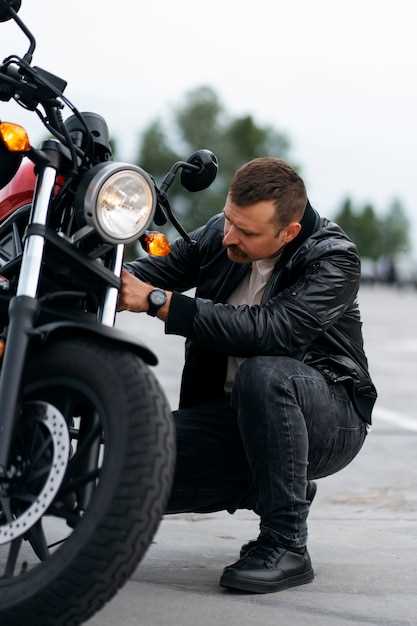
Owning a motorcycle is not just about enjoying the thrill of riding; it also requires a commitment to maintenance in order to achieve peak performance. A well-maintained bike ensures not only a smoother ride but also enhances safety on the road. By taking the time to care for your motorcycle, you can extend its lifespan and improve its efficiency.
Maintenance is an integral aspect of motorcycle ownership that often gets overlooked. Regular checks on critical components such as brakes, tires, and fluids can prevent future issues and costly repairs. Whether you are a seasoned rider or a newcomer, understanding the basic principles of motorcycle maintenance will empower you to keep your bike in top condition.
This article will provide essential tips and guidelines to help you perform effective maintenance on your motorcycle. From routine inspections to advanced care, you will learn how to optimize your bike’s performance, ensuring that every ride is safe, enjoyable, and exhilarating.
Regular Oil and Filter Changes for Optimal Engine Health

Regular oil and filter changes are fundamental aspects of motorcycle maintenance that significantly influence engine performance. Engine oil lubricates the moving parts, ensuring smooth operation while minimizing friction and wear. Over time, oil can degrade and become contaminated with dirt, metal particles, and combustion byproducts.
To maintain optimal engine health, it is essential to change the oil at the recommended intervals specified by the manufacturer. This practice not only helps in preserving the quality of the oil but also ensures that your engine remains protected from unnecessary damage. Fresh oil provides better viscosity and superior lubrication, which are crucial for high-performance motorcycles.
The oil filter plays a vital role in this process by trapping contaminants that could otherwise circulate in the engine. A clogged or dirty filter can lead to restricted oil flow, resulting in increased operating temperatures and potential engine failure. Regularly replacing the oil filter alongside the oil ensures that the system remains clean and efficient, further enhancing performance.
Additionally, using the right type of oil suited for your motorcycle’s engine will positively impact its efficiency. Synthetic oils, for example, often provide better performance in extreme conditions compared to conventional oils. Always consult your owner’s manual to select the most suitable oil and filter for your specific model.
In summary, prioritizing regular oil and filter changes is critical for maintaining optimal engine health and performance. This simple maintenance task can extend the life of your motorcycle and contribute to a smoother, more reliable ride.
How to Properly Adjust and Maintain Your Motorcycle’s Chain
Maintaining your motorcycle’s chain is crucial for ensuring peak performance and prolonging the life of your bike. A well-adjusted chain reduces wear on components and enhances the overall efficiency of power transfer from the engine to the rear wheel. To keep your chain in optimal condition, follow these steps.
First, check the chain tension. With the bike on a flat surface and the rear wheel elevated, locate the chain’s slack. Most manufacturers specify the ideal slack range, typically between 1 to 2 inches. Adjust the tension using the rear axle adjusters; turn them evenly on both sides to maintain wheel alignment.
Next, inspect the chain for wear and damage. Look for signs of rust, stiff links, or excessive elongation. A worn chain can lead to decreased performance and potential damage to other components, necessitating immediate replacement if needed.
Regular cleaning is essential for maintaining chain health. Use a dedicated chain cleaner and a soft brush to remove dirt and debris. After cleaning, rinse the chain with water and dry it thoroughly to prevent moisture buildup, which can lead to rust.
Lubrication is another key aspect of chain maintenance. Apply a high-quality chain lubricant evenly along the length of the chain while rotating the rear wheel. This helps reduce friction and wear while ensuring smooth operation. Perform this task after each cleaning or at least every 300 miles, depending on your riding conditions.
Finally, keep an eye on the chain alignment. Misaligned chains can lead to uneven wear and can affect your bike’s performance. Use a chain alignment tool or visually inspect to ensure that the chain runs straight between the sprockets.
By regularly adjusting and maintaining your motorcycle’s chain, you can optimize your bike’s performance and ensure a safer, smoother ride.
Essential Tire Maintenance for Enhanced Grip and Handling

Tire maintenance plays a crucial role in ensuring your bike delivers optimal performance. Regularly inspecting your tires can significantly enhance grip and handling, resulting in a safer and more enjoyable riding experience.
First, check the tire pressure frequently. Maintaining the correct pressure is essential for maximizing grip and ensuring even tire wear. Under-inflated tires can lead to reduced agility and increased rolling resistance, while over-inflated tires can result in a harsh ride and decreased traction. Refer to your bike’s manual for the recommended tire pressure and adjust accordingly.
Next, inspect the tread depth and wear patterns. Worn-out tires can compromise handling, making it difficult to navigate corners effectively. Use the penny test by inserting a coin into the tread; if you can see the top of Lincoln’s head, it’s time to replace your tires. Additionally, check for uneven wear, which may indicate alignment issues that should be addressed.
Cleaning your tires is also essential for maintaining grip. Remove any debris, dirt, or brake dust that may accumulate on the surface. A clean tire can improve traction, especially in wet conditions. Use a gentle soap solution and a soft brush to scrub the tire sidewalls without damaging them.
Finally, rotate your tires regularly to promote even wear. This is particularly important for bikes with different tire types, as it helps maintain consistent performance across all wheels. Following these maintenance tips will ensure your bike continues to perform at its best, enhancing both grip and handling, and providing a more thrilling ride.




